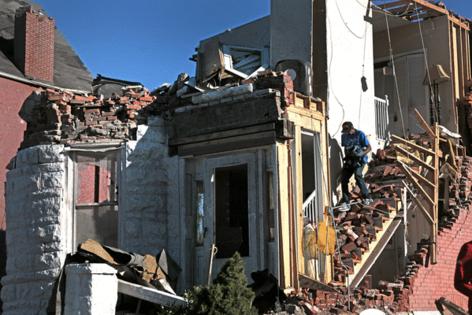St. Louis has lost residents for decades. The tornado could nudge more to leave
Published in Home and Consumer News
ST. LOUIS — The sounds of nail guns and roofing hammers echoed through the neighborhood as Lisa Mannery surveyed the impassible pile of branches stacked in her backyard. An HVAC unit hung precariously from the roof of the still-closed Save A Lot on Natural Bridge Avenue behind her house.
Her roof, like many others nearby, was covered by a blue tarp, though she’s able to stay in her home as she sorts through insurance and contractors.
But many of Mannery’s neighbors are living elsewhere while their homes are repaired.
Several doors down, Vickii Grady said she will be staying elsewhere as she awaits fixes to her home. Another resident, David Jackson, said he’s seen more than few U-Haul trucks in the two weeks since a tornado carved a path of destruction through St. Louis, killing five and significantly damaging nearly 2,500 buildings.
The brunt of the storm fell on north St. Louis, already weighed down with a long decline in population and the resulting vacancy and associated problems. But the block of San Francisco Avenue near Natural Bridge and Newstead avenues where Mannery lives was mostly intact, and she is confident that her neighbors will rebuild and return to what she said is a tight-knit community.
“If we can make it through this, we can make it through anything,” said Mannery, 69. “And once we get this cleaned up, they coming back, and we going to be just as close as we were before.”
Her sentiment is shared by many on the city’s north side, who have stayed despite weathering spotty services, crime and vacant buildings for years before the tornado. But experts worry the natural disaster will only accelerate the city’s decades-long loss of population.
The section of north St. Louis hit by the tornado already had seen population decline before disaster struck on May 16. U.S. Census population estimates show a decline of about 2,000 people there between 2020 and 2023, according to a Post-Dispatch analysis.
While the destruction caused by the tornado isn’t likely to reduce overall regional population, it probably will exacerbate north St. Louis’ population loss, said Ness Sándoval, a St. Louis University sociology professor who studies the region’s demographics. Since 2010, he points to census estimates that show more than 7,500 people had already left the tornado zone. The neighborhoods it hit were the “epicenter of Black population loss” in the city, he said.
“It’s not just millions of dollars that’s going to fix this — we’re talking hundreds of millions of dollars to try to stabilize this, at a minimum,” Sándoval said. “If the city is unable to do this and respond in a rapid rate, then this could accelerate pretty fast.”
Grasping for answers
The tornado hit as St. Louis leaders already were grasping for ways to stem a loss of population that shows no sign of abating.
Annual estimates released last month by the U.S. Census painted a grim picture for a city that has watched residents leave for more than a half-century. St. Louis lost an estimated 3,000 residents last year and more than 20,000 since 2020, sliding to just under 280,000 people. It was the largest decline on a percentage basis — 7.2% — among large U.S. cities of more than 200,000 people, Sándoval said.
Mayor Cara Spencer campaigned on reversing the city’s population loss, and last week, she doubled down on that goal, telling residents and clergy at a north side church she aimed to keep every displaced resident in the city. Her supporters welcomed the optimism, but a couple of days later, Spencer acknowledged keeping everybody and growing the city’s population in the wake of the disaster was a tall order.
“We’re trying to be intentional about keeping people in the community,” Spencer told the Post-Dispatch Thursday. “We don’t want to prevent anybody from taking housing where they can, but we are trying to be intentional about keeping people here.”
At least one resident was already looking for a new place outside the city. Caleb Land’s building was one of dozens heavily damaged in the hard-hit DeBaliviere Place neighborhood just north of Forest Park. South of Delmar Boulevard and the infamous “Delmar divide” that splits St. Louis in two, it was one of the few city neighborhoods that was growing, with new apartments catering to young professionals and students at nearby Washington University.
Now, the once-leafy streets are lined with downed tree limbs and piles of building debris, while boards cover the windows of the stately brick apartment buildings.
The ceiling in Caleb Land’s apartment gave way during the storms after the tornado in St. Louis on Thursday, May 29, 2025. “I am so lucky that it didn’t hit anything important,” Land said. He lives in the DeBaliviere Place area.
The ceiling had collapsed in Land’s unit, and the building manager informed him and the 17 other tenants in the building at 308 Clara Avenue they had to leave by May 31 because Ameren would not restore power until the roof was repaired, according to an email Land shared. (A spokeswoman for the city’s building division said it had not officially condemned any buildings as of Friday, so it had not forced the landlord’s decision.)
On Friday, Land, 35, was busy packing up his belongings to move to a storage unit while he finds a new place, probably in St. Louis County.
“I’d like to be, yeah, at least 20 minutes away from, like, the congestion of it all,” he said. “I have a dog, so, you know, trying to find a place that allows pets and, you know, a little bit of space for him, and just trying to relax because this has been awful.”
While Land hails from one of the densest neighborhoods in the city, where a single building’s damage can displace more than a dozen people, those are likely the neighborhoods easiest to repopulate because the type of residents who live there are more likely to return, Sándoval said.
“That’s one of the strengths of the city is that it does attract a lot of young people,” he said. “It’s attracting a highly educated population now that are younger.”
But it’s families with children who are crucial for significant population growth, Sándoval said, and those families have been fleeing the city in droves, particularly from the north side.
Keeping families with children
St. Louis Public Schools Superintendent Millicent Borishade said the district would take it “day by day” when asked whether she anticipated a significant drop in enrollment due to the tornado. School board President Karen Collins-Adams said it was “not something the district can predict.” But she said in other cities hit by large disasters, there has been a return of families and population after some time.
“It’s only temporary because people like to come back to their roots,” Collins-Adams said.
It’s true that other cities that have undergone disasters see a return of residents, Sándoval said. But if families experience better schools in suburban St. Louis school districts while they’re displaced, they’re less likely to come back to the city.
“Once families with children leave, even if it’s temporary, and they get out to the suburbs and then they start to compare the school districts in the suburbs to the St. Louis public school district, it’s going to be very difficult to bring those families back in,” Sándoval said. “And so that’s the risk the city has. If families have to move out of the city temporarily, what history has shown us is that that temporary move becomes permanent.”
On Lee Avenue between O’Fallon and Fairground parks, convenience store owner Mustafa Hamed was back open selling snacks and groceries Tuesday after a week without power. The co-owner of Yeatman Market II at the corner of Turner and Lee avenues said many of his customers say they will stay or rebuild, but he expects business to slow down.
“People lost their houses, and they’re leaving,” Hamed said. “It’s going to be different.”
Several blocks south, Greg Smiley, who raised his kids from a century-old home on Taylor Avenue and then bought the one next door for them, said “change was trying to happen before the tornado hit.” People were upgrading their houses, he said. A new convenience store and shopping plaza at Natural Bridge and Newstead recently opened but was all but destroyed by the storm.
“Now you look at it, they got to start all from scratch again,” Smiley said.
Smiley, 57, has already fixed the roofs on his homes, helped in part with free lumber given away by volunteers. He grew up in the neighborhood, and he believes his neighbors “ain’t going nowhere.”
“You want to be part of the rebuilding, definitely when you’ve lived here all your life,” he said. “If they going to upgrade around here, be a part of it.”
Grady, one of the residents on San Francisco who will stay elsewhere while her house is repaired, is also confident her neighbors will come back. But it won’t be the same.
“It’s not going to be the north side I’ve known for 36 years because most of the buildings that I’ve seen my entire life, they’re gone,” Grady said. “It’s just going to be the new north side.”
(Josh Renaud of the Post-Dispatch contributed to this report.)
©2025 STLtoday.com. Distributed by Tribune Content Agency, LLC.








Comments